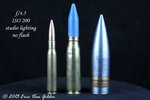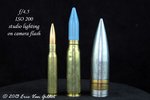Airframes
Benevolens Magister
Well, I got some reasonably good results, some bad results, and some passable results! The latter were my fault, due to stiff hands, although partly the design of the 70-300mm lens barrel, resulting in slight camera shake (non stabilised lens) and therefore not quite sharp.
The bad results were varied - out of focus due to the setting used, or slow re-focus of the lens, with the worst being a total 'white out' of the background, but with the subject being pin-sharp and nicely exposed. This seems to be an inability, under certain conditions, to expose correctly overall, again depending on settings, and was prevalent in AF-C, spot metering, shutter priority, but did happen in manual, the latter mainly my fault (see below), although by the end of shooting, was beginning to think a problem had developed. These results were when shooting against bright, white cloud, so no doubt metering would be affected!
I found the best overall settings were in Auto mode, manual shutter and aperture, although by the end of the air show, some results were poor, probably due to my inattention because of heat and fatigue.
As expected, results in full auto were mixed and varied, but I was disappointed at the lack of instant control in AF-C etc. This, however, might be a deficiency of the Sigma lens, as the motor could take a second to re-focus in some cases - far too slow for fast-moving subjects.
All the above refer to ground to air shots of the displays, the static shots, or moving ground subjects being fine.
The main thing was, that the field was so crowded, with long delays even getting in, that most of the time, the closest I could get to the crowd line was 500 metres back - so around 800 metres from even the runway!
Some shots were taken about 300 metres from the runway threshold, although the angle of view was not the best, with a good proportion of shots taken from around 850 metres from the runway - the display axis being another 200 metres beyond this!
But the main thing, I've learned a little more about the camera, and its controls, and at least I now know what settings don't suit this type of photography!
Oh, for the advantages of a DSLR, with the instant versatility of a 35mm SLR !!
The bad results were varied - out of focus due to the setting used, or slow re-focus of the lens, with the worst being a total 'white out' of the background, but with the subject being pin-sharp and nicely exposed. This seems to be an inability, under certain conditions, to expose correctly overall, again depending on settings, and was prevalent in AF-C, spot metering, shutter priority, but did happen in manual, the latter mainly my fault (see below), although by the end of shooting, was beginning to think a problem had developed. These results were when shooting against bright, white cloud, so no doubt metering would be affected!
I found the best overall settings were in Auto mode, manual shutter and aperture, although by the end of the air show, some results were poor, probably due to my inattention because of heat and fatigue.
As expected, results in full auto were mixed and varied, but I was disappointed at the lack of instant control in AF-C etc. This, however, might be a deficiency of the Sigma lens, as the motor could take a second to re-focus in some cases - far too slow for fast-moving subjects.
All the above refer to ground to air shots of the displays, the static shots, or moving ground subjects being fine.
The main thing was, that the field was so crowded, with long delays even getting in, that most of the time, the closest I could get to the crowd line was 500 metres back - so around 800 metres from even the runway!
Some shots were taken about 300 metres from the runway threshold, although the angle of view was not the best, with a good proportion of shots taken from around 850 metres from the runway - the display axis being another 200 metres beyond this!
But the main thing, I've learned a little more about the camera, and its controls, and at least I now know what settings don't suit this type of photography!
Oh, for the advantages of a DSLR, with the instant versatility of a 35mm SLR !!


